
Research Article
Phys Med Rehabil Int. 2023; 10(1): 1210.
Effectiveness of High-Intensity Laser Therapy in Patients with Lateral Epicondylitis on the Level of Disability, Pain, Grip Strength and Quality of Life: A Systematic Review and Meta-Analysis
Shun-Kei Tang; Wing-Lam Hon; So-Wa Ip; Ho-Yin Chung; Tiffany Ching-Man Choi*
School of Health Sciences, Caritas Institute of Higher Education, Hong Kong
*Corresponding author: Tiffany Ching-Man Choi School of Health Sciences, Caritas Institute of Higher Education, 2 Chui Ling Lane, Tseung Kwan O, New Territories, Hong Kong. Email: cmchoi@cihe.edu.hk
Received: February 15, 2023 Accepted: March 29, 2023 Published: April 05, 2023
Abstract
The systematic review and meta-analysis aim to evaluate the clinical effectiveness of High-Intensity Laser Therapy (HILT) in managing Lateral Epicondylitis (LE). The electronic databases (Pubmed, Europepmc, NCBI-NIH, Medline, Science direct, and google scholar) were searched. Studies that meet the following criteria are included in the review: 1) experimental studies, 2) participants were diagnosed with LE, 3) at least one of the treatment groups included HILT, and 4) at least one research outcome was on level of disability of elbow, level of perceived pain, handgrip strength, or quality of life. The last search was conducted in May 2021. Six studies (n=321) were included in the review. Overall, HILT significantly reduced pain comparing with the active controls (weighted mean difference: -0.65; 95% CI-0.98 to -0.33; p=0). Also, effect of HILT on improving participants’ quality of life in physical domain was significantly better than that of the active controls. (Standardized mean difference: 0.486; 95% CI=0.066 to 0.906; p=0.023). Though all included studies revealed that HILT had a higher therapeutic effect than the comparators in aspects of grip strength and level of disability, no significant difference was detected. These outcomes show a “weak” strength of evidence in quality assessment. In conclusion, although HILT showed a positive impact on LE, the number of studies on HILT was limited and the risk of selection, performance and detection bias was revealed. Therefore, further well-designed studies are warranted (250 words).
Keywords: Laser therapy; Physical therapy modality, Rehabilitation; Tennis Elbo
Introduction
Lateral Epicondylitis (LE) of the elbow, also known as “tennis elbow”, is a musculo-tendinous disorder of the wrist extensor tendons attached to the common point of origin on the lateral humeral epicondyle [1]. Muscles corresponding to these tendons are extensor digitorum, extensor carpi radialis longus, extensor carpi ulnaris and extensor carpi radialis brevis. LE is often presented with local pain and tenderness on the lateral side of elbow, aggravated by resisted wrist and elbow extension movements [2]. Local pain, together with diminished handgrip strength, cause individuals with LE functional limitation and disability in daily life [3].
High-Intensity Laser Therapy (HILT) is a type of physiotherapy treatment for an individual with LE. For its mechanism of action, through delivering the irradiation to the soft tissue, it can trigger the photochemical effect at the cellular level which induces inflammation inhibition, cell apoptosis, and collagen synthesis promotion. All of these contribute to tendon healing and pain alleviation in LE patients [4]. There are two categories of laser therapies, namely HILT and Low-Intensity Laser Therapy (LILT). HILT has an output power of more than 0.5 watts while LILT has an output power lower than 0.5 watts. Also, HILT has a lower duty cycle, shorter emission time, and utilizes lights closer to the infrared band. Therefore, it can deliver greater energy to a deeper tissue than low-level laser therapy [5-7].
Compared to LILT and other conventional physiotherapy modalities, HILT is a relatively new intervention on LE. In the past decade, there was an increasing number of experimental studies comparing HILT’s therapeutic effects on LE with other modalities [8-12]. However, there was limited systematic review or meta-analysis on related studies [13,14]. Nor was there any well-established evidence-based guideline for its application to LE. Therefore, further study to investigate HILT’s effect on LE is indicated.
The research question of this review was: How effective is HILT on managing LE? To answer this question, a systematic review with meta-analysis was performed on the available experimental studies which investigated the effects of HILT on LE. The current review aims to provide clinically relevant indications of the effectiveness of HILT and contribute to further studies on devising an evidence-based clinical guideline.
Method
An extensive search was conducted in May 2021 in electronic databases (Pubmed, Europepmc, NCBI-NIH, Medline, Science direct, and google scholar). We imposed no restrictions on publication and language of the studies during the search. Searching keywords were as below: (“Tennis elbow” or “Lateral elbow tendinopathy” or “Extensor tendinopathy” or “Lateral epicondylitis” or “Extensor tendonitis” or “Lateral elbow”) And (“Hot laser therapy” or “High power laser therapy” or “High level laser” or “high energy laser” or “High intensity Laser therapy” or “Therapeutic laser” or “’Medical laser” or “Laser therapy” or “biostimulation laser”). A manual search was also carried out in the reference list of the selected studies.
This systematic review and meta-analysis included studies that met the following criteria: 1) research participants were diagnosed with unilateral or bilateral LE; 2) study design was experimental; 3) at least one of the treatment groups included HILT; 4) at least one statistically significant research outcome was level of disability of elbow, level of perceived pain, handgrip strength, or quality of life; 5) full text of studies were available.
Four reviewers screened the titles and abstracts of all the identified literature independently according to the predetermined eligible criteria. When the study was found to be potentially eligible, reviewers would review the study in full text. Any disagreement over the literature’s eligibility was resolved by discussion among the reviewers.
To assess the Risk of Bias (ROB) of the included studies, the Cochrane risk-of-bias tool for randomized trials (ROB 2) was used. The software RevMan 5 was used in order to generate the results. The tool consisted of six main bias assessment items including the selection bias, performance bias, detection bias, attrition bias, reporting bias, and other biases. The available answers to each bias were “low risk of bias”, “unclear risk of bias” and “high risk of bias” [15].
The ROB was assessed by four reviewers independently. Any disagreement was resolved by discussion until a consensus was reached among the four reviewers. No study was rejected based on the result of ROB assessment.
Grading of Recommendations, Assessment, Development, and Evaluation (GRADE) tool was adopted to evaluate the quality of evidence for the major outcomes of this review. The body of evidence will be down graded or upgraded to different levels of quality (“high”, “moderate”, “low”, and “very low”) based on procedures as instructed by the Grading of Recommendations, Assessment, Development, and Evaluation guideline [16]. The GRADE pro Guideline Development Tool software was utilized to perform a summary table of the findings [17].
Study characteristics and statistical data were extracted from the selected studies. Study characteristics included the author, publication year, study design, sample size, age (mean±SD), gender in percentile, country, diagnosis, intervention of experimental group, intervention of comparator group(s), evaluation timing (short term and long term follow up), and outcomes. Data for statistical meta-analysis included 1) level of disability of elbow, 2) level of perceived pain, 3) handgrip strength and 4) quality of life. Significance levels of all data extracted were set at p<0.05. Data extraction was carried out by four reviewers. Any disagreement was resolved by discussion until a consensus was reached among the four reviewers.
Data analysis was performed on Comprehensive Meta-analysis software. The effect size of Weighted Mean Difference (WMD) was adopted if all analytical data extracted were continuous and of the same units while the effect size of Standardized Mean Difference (SMD) was adopted if the data were continuous and of different units. Significance levels of all data were set at p<0.05. The 95% CI of each effect size was calculated. According to the Cochrane group guideline, in meta-analysis involving overlapping participants such as a multi-arm study, the sample size of the shared group was divided [18]. In the heterogeneity test, if the chi-squared value was p<0.05 or I² value ≥50%, the heterogeneity was considered as significant, and the random effect model was selected. If heterogeneity was not significant, the fixed effect model was selected.
Results
The result of the extensive literature search was shown in (Figure 1). A total of 51,077 studies were identified where 10,077 studies were searched from the electronic databases and 41,000 studies were searched from the google scholar. Based on title screening, 51,042 studies were removed due to duplication or irrelevance. Nine studies which were not related to HILT were excluded after the abstract screening. At the stage of full-text screening, 20 more studies were excluded as laser output did not fulfill the criteria of HILT or it did not fulfil the selection criteria. Finally, six eligible studies were included in this study.
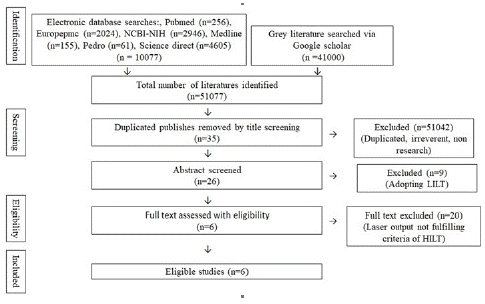
Figure 1: Prisma flow chart.
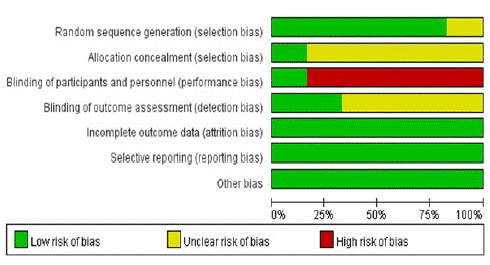
Figure 2A: Risk bias summary graph.
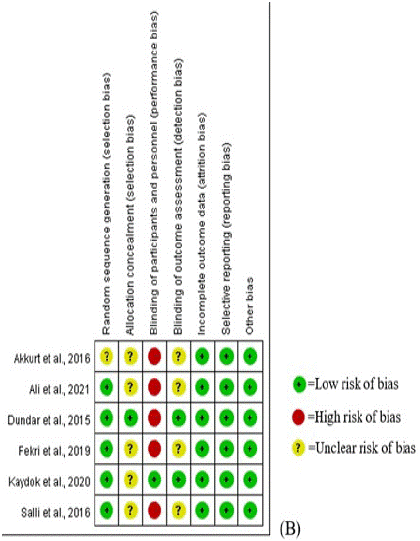
Figure 2B: Risk bias summary graph.
Study characteristics of the six included studies are shown in Table 1. The study design of two studies were randomized controlled trials [9,10], three studies were randomized clinical trials [8,11,12] and one study was a quasi-experimental study [19]. The mean sample size of the six included studies was 53.5 (mean±SD = 53.5±23.4) and the mean age was 44.1 years old (mean±SD = 44.1±5.67). The gender percentile in different study groups was mainly in the proportion of 70 female: 30 male and 50 female: 50 male. Four studies were conducted in Turkey [8,9,11,19], one was conducted in Egypt [10], and one was in Iran [12]. The studies mainly investigated the therapeutic effect of HILT on either unilateral or bilateral LE and compared the effect of HILT to other active comparators including LE bandage, brace, LILT, placebo and ultrasound. The treatment parameters of HILT were concluded in (Table 1). The major outcomes of the included studies were handgrip strength, perceived pain level, level of disability, and quality of life. All studies measured the outcomes immediately after the treatment. One study provided an additional three-month follow-up measurement [9], and one study provided a six-month follow-up measurement [10].
Authors / Publication year
Study Design
Sample size
Age (mean±SD)
Country
Diagnosis
Intervention of experimental group(s)
Intervention of Comparator(s) group
Evaluation timing
Out comes
[8]
Randomized clinical trial
Total sample: n=65
HILTagroup: n=31
Bandage group: n=34HILTa:47.5±8.9
Bandage:45.6±7.3HILTa
Female: 74.19%
Male: 25.81%LEbbandage:
Female: 70.59%
Male: 29.41%Turkey
Unilateral LEb
First 4 sessions: 4W 6J/cm2 in 75s (analgesic effect)
Later 6 sessions: 6W/cm2 100-150J in 30 (biostimulation effect)
Treatment Period: 10 sessions in 2 weeks (5days/week)LEbbandage:Wear bandages for 6 weeks
Post-treatment
- Hand grip strength
- Perceived pain
- Level of disability of the elbow
- Quality of life
[9]
Randomized controlled trial
Total sample: n=91
HILTagroup: n=30
Sham group: n=31
Brace group: n=30HILTa: 32.6 ±10.9
Sham: 33.4±11.2
Brace: 33.6±-9.8HILTa:
Female: 43.33%
Male: 56.67%Sham:
Female: 45.16%
Male: 54.84%Brace:
Female: 50%
Male: 50%Turkey
Unilateral LEb
Type of laser: pulsed Nd:YAGd laser therapy, 1064nm
1,275J/15-minsession in 3 phases:
1st phase:625 J in total
2nd phase: 25 J in total
3rd phase: 625 J in total
Treatment period: 15 sessions in 3 weeksSham: Placebo
Brace:Use lateral counterforce brace for 4 weeks
Post-treatment and
3 months follow up
- Hand grip strength
- Perceived pain
- Quality of life
- Common extensor tendon thickness
[10]
Randomized controlled trial
Total sample: n=45
HILTa+ultras-und group:
n=15
HILTagroup:
n=15
ultrasound group:
n=15Total sample: 44.9±7.3
Total sample:
Female: 53.33%
Male: 46.67%Egypt
Bilateral or unilateral LEb
Type of laser:Elettronica Pagani, Italy, 808 and 915nm
Each session: 5J/cm2 for 5 min
Total energy/session: 960J
Total area treated/session: 9cm2
Treatment period: 12 sessions in totalHILTa+ ultrasound and
ultrasound only:Dose of ultrasound= 1.5 W/cm2 for 5 minutes, at a frequency of
3MHzPost-treatment and 6 months follow up
- Hand grip strength
- Perceived pain
- Level of disability of the elbow
[19]
Quasi experimental study
Total sample: n=30
Total sample: 47.2±9.7
Total sample:
Female: 73%
Male: 27%Turkey
Bilateral or unilateralLEb
First 4 sessions 4W 6J/cm2 in 75s
Later 6 sessions: 6W 100-150J/cm2 in 30s for 12 min
Treatment period: 10 sessions in 2 weeksN.A.
Post-treatment
- Hand grip strength
- Perceived pain
- Level of disability of the elbow
- Quality of life
[11]
Randomized clinical trial
Total sample: n=60
HILTagroup: n=30
LILTc group: n=30HILTa:45.4±10.3
LILTc :43.1±-8.3HILTa:
Females: 70%
Males: 30%LILT:
Females: 77%
Male: 23%Turkey
Unilateral LEb
Type of laser: BTL-6000, Ince., Greenville, 12W, 1064 nm
First three sessions: 8W, 6J/cm2 in 75s (analgesic effect)
Lateral six sessions: 6W, 120to 150J/cm2 in 30s (biostimulator effect)
Treatment period: 9 sessions in 3 weeksLILTc:
Type of laser: gallium aluminum arsenide infrared diode laser, 904nm
Dosage:240MW, 2.4 J/cm2 in 30s
Treatment period: 9 sessions in 3 weeksPost-treatment
- Hand grip strength
- Perceived pain
- Level of disability of the elbow
- Quality of life
[12]
Randomized clinical trial
Total sample: 30
HILTagroup: n=15
LILTc group: n=15Total sample (min. age to max. age): 32 to 67
N.A.
Iran
Unilateral LEb
Type of laser: MLS Laser, Model M6 (ASA), 25 W, 808nm
Total energy: 272. 4J in 5 cm diameter treatment region
Energy density: 13.89 J/ cm2 with a 700-hertz frequency for 3 mins
Treatment period:10 sessionsLILTc:
Type of laser:
AL170 Model procured from Novin Company
Total energy, 808 nm
Energy density:
8 J/cm2 with
250-Hertz frequency
for 4 minutes
Treatment period:10 sessionsPost- treatment
- Perceived pain
- Tenderness
Table 1: Study characteristic of the included studies.
In six of the studies involving 305 participants, the participants’ perceived pain level was measured by a continuous 10cm visual analogue scale [8-12]. As shown in Figure 3, it shows that HILT significantly reduced pain comparing with the comparators including LILT, ultrasound, splinting, placebo and bandage (WMD: -0.65; 95% CI -0.98 to -0.33; p<0.001). A trial revealed that there was no WMD when comparing the HILT’s pain-relieving effect with that of splinting (WMD=0; CI -0.61 to 0.61; p>0.99) [10]. Significant WMD was noted in the trail comparing HILT to ultrasound (WMD = -1.5; 95% CI -2.38 to -0.62; p=0.001) [10] and placebo (WMD = -0.9; 95% CI -1.57 to -0.23; p=0.009) [9]. As to the subgroup analysis, WMD from two studies [11,12] show that there was not significant mean between HILT and LILT (WMD=- 0.57; 95% CI -1.18 to 0.03; p=0.063). Due to the presence of heterogeneity (I2=34.57%, p=0.177), a fixed-effect model was adopted.
The grip strength was measured by dynamometers in the studies. As shown in Figure 4, in five trials involving 244 participants, the pooled SMD indicated that the HILT’s effect on increasing the grip strength did not significantly differ from the comparators including LILT, ultrasound, splinting and bandage [8-12] (SMD=0.22; 95% CI -0.03 to 0.48; p=0.082). Nevertheless, all the included studies revealed that HILT showed a higher therapeutic effect than comparators on improving the grip strength though the SMD was not statistically significant. Due to the absence of heterogeneity (I²=0%, p=0.801), a fix-effect model was adopted.
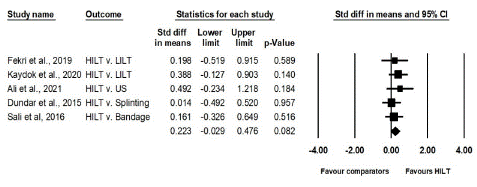
Figure 4: SMD in grip strength between HILT and comparators.
Disabilities of the Arm, Shoulder and Hand (DASH) and quick disabilities of the arm, shoulder and hand questionnaire (Quick DASH) were used in order to measure the disability of participants. As shown in Figure 5, in three studies involving 154 participants, the pooled SMD indicated that the HILT’s effect on improving disability was not significantly higher than the comparators including LILT, ultrasound and bandage (SMD, 0.25; 95% CL–0.56 to 0.07; p=0.129) [8,10,11]. Nevertheless, all the included studies revealed that HILT therapy showed a higher therapeutic impact than comparators on improving the disability though the SMD was not statistically significant. Due to the absence of heterogeneity (I²=0%, p=0.830), a fix-effect model was adopted.
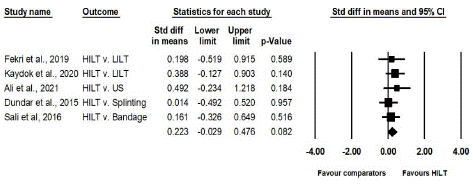
Figure 5: SMD in score of disability between HILT and comparators.
The sub-items of the Short Form (36) Health Survey were used in order to measure the participants’ quality of life in the mental and physical aspects. As shown in Figure 6, in three studies involving 184 participants, the pooled SDM indicated that the HILT effect on increasing quality of life was not significantly higher than the comparators including LILT, splinting and bandage (SMD: -0.22; 95% CI -0.07 to 0.51; p=0.138) [8,9,11]. However, HILT could significantly improve participants’ quality of life in the physical aspect compared to the comparators (SMD: 0.49; CI 0.07 to 0.91; p=0.023), while there was no significant mean difference noted in the mental health aspect (SMD: -0.03; CI -0.43 to 0.38; p=0.903). Due to the absence of heterogeneity (I2=12.33%, p=0. 336), a fix-effect model was adopted. In addition, as shown in Table 2, the study also involved 30 participants to compare the combined effect of HILT and ultrasound with HILT alone [10]. The combined therapeutic effect was larger than the therapeutic effect of HILT alone in the aspect of pain relieve (MD=-0.7; 95% CI -1.31 to -0.09), DASH score (MD=-3.70; 95% CI -0.80 to 3.40) and grip strength (MD=4.5; 95% CI -0.63 to 9.63).
Outcome
MDa (CI)
Perceived pain
MD=-0.7; 95% CI -1.31 to -0.09
Level of disability
MD = -3.70; 95% CI -10.80 to 3.40
Grip strength
MD=4.5; 95% CI -0.63 to 9.63
amean difference
Table 2: Combined therapeutic effect of HILT and ultrasound on LE.
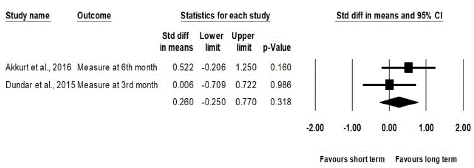
Figure 6: SMD in the score of quality of life between HILT and comparators.
As shown in Figure 7, two trials involving 60 participants compared the long-term effect of HILT on pain relief (measured at 3rd or 6th month after the intervention) to the short-term effect of HILT (measured immediately after two to three weeks of intervention) [9,19]. Results indicated that no SMD was found between the overall short- and long-term effect of HILT (WMD =-0.98; CI -1.97 to 0.01; p=0.052). However, in the trial measuring the pain at the 6th month [19], it had a much higher WMD (WMD = -1.94; 95% CI -3.42 to -0.46; p=0.010) on pain relief than the trial measuring at the 3rd month (WMD= -0.70; 95% CI -1.53 to 1.13; p=0.769) [9]. Due to the presence of heterogeneity (I²=65.92%, p=0.087), a random-effect model was adopted.
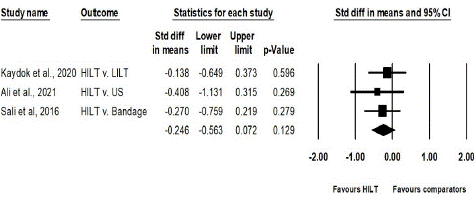
Figure 7: WMD in pain intensity pain between short term and long-term effect of HILT.
As shown in Figure 8, two trials involving 60 participants compared the long-term effect of HILT on grip strength (measured at three or six months after the intervention) to the short-term effect (measured immediately after two to three weeks of intervention) [9,19]. Results indicated that no significant SMD was found between the overall short and long-term effects of HILT on increasing grip strength (SMD=0.26; 95% CI -0.25 to -0.77; p=0.318). However, in the trial measuring grip strength at the 6th month [19], it had a higher SMD (SMD=0.52; 95% CI -0.21 to 1.25; p=0.160) on increasing grip strength when compared to the trial which measured the grip strength at the 3rd month (SMD=0.006; 95% CI–0.71 to 0.72; p=0.986) [9]. Due to the absence of heterogeneity (I²=0%, p=0.322), a fix-effect model was adopted.
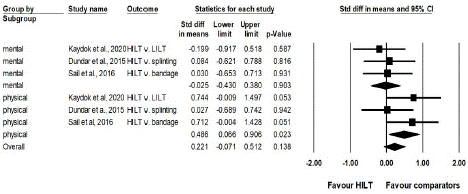
Figure 8: SMD in grip strength between short- and long-term effect of HILT.
The summarized findings and judgment detail of the GRADE approach are shown in Table 3a, 3b,3c, and 3d. For the outcomes which compare the effect of HILT to other comparators for LE, the overall quality is “low” [8-12]. The reason to downgrade the evidence is that the limitation of the study design contributes to the ROB. Also, the inconsistent method of HILT application between studies further downgrades the evidence. For the outcomes which compare the short-term and long-term effects of HILT on epicondylitis, the overall quality is “very low” [9,19]. The degradation is mainly contributed by the small sample size, severe limitations in the study design of one study, and serious heterogeneity between studies. As to the outcome of the combined therapeutic effect of HILT with ultrasound or low laser intensity therapy, the overall quality is “very low” [10]. It is because evidence provided by limited studies susceptible to impreciseness.
Quality assessment
№ of patients
Absolute Effect
(95% CI)Quality
№ of studies
Study design
Risk of bias
Inconsistency
Indirectness
Imprecision
Other considerations
HILT a
other comparators
Outcome: Mean difference in pain intensity between HILT aand comparators
5
randomized trials
serious
serious
not serious
not serious
none
150
155
MD 0.65 lower
(-0.98 lower to 0.33 lower)◯◯
LowOutcome: Standardized mean difference in grip strength between HILT aand comparators
5
randomized trials
serious
serious
not serious
not serious
none
120
124
-SMD 0.22 higher
(0.03 lower to 0.48 higher)◯◯
LowOutcome: Standardized mean difference in score of disability between HILT aand comparators
3
randomized trials
serious
serious
not serious
not serious
none
75
79
SMD 0.25 higher
(0.56 higher to 0.07 higher)◯◯
LowOutcome: Standardized mean difference in score of physical quality of life between HILT atherapy and comparators
3
randomized trials
serious
serious
not serious
not serious
none
44
47
-SMD 0.49 higher
(0.07 higher to 0.91 higher)◯◯
LowOutcome: standardized mean difference in score of mental disability between HILT aand comparators
3
randomized trials
serious
serious
not serious
not serious
none
46
48
-SMD 0.03 lower
(0.43 lower to 0.38 higher)◯◯
LowaHigh-intensity laser therapy; bLateral epicondylitis
Table 3a: Effect of HILTa compared to other comparators for LEb [8-12].
Quality assessment
№ of patients
Absolute effect
(95% CI)Quality
№ of studies
Study design
Risk of bias
Inconsistency
Indirectness
Imprecision
Other considerations
short term HILT a
long term HILTa
Outcome: Mean difference in pain intensity between short-and-long term effect of HILTa
2
randomized trials and quasi-experimental study
very serious
very serious
not serious
not serious
none
30
30
SMD 0.98 lower
(1.97 lower to 0.01 higher)◯◯◯
Very lowOutcome: Standardized mean difference in grip strength between short- and long-term effect of HILTa
2
randomized trials and clinical trials
very serious
very serious
not serious
not serious
none
15
15
SMD 0.26 higher
(0.25 lower to 0.77 higher)◯◯◯
Very lowaHigh-intensity laser therapy; bLateral epicondylitis
Table 3b: Short term HILTa outcome measurement compared to long term HILTa measurement for LEb [9,19].
Quality assessment
№ of patients
Absolute effect
(95% CI)Quality
№ of studies
Study design
Risk of bias
Inconsistency
Indirectness
Imprecision
Other considerations
HILTa
ultrasound
Outcome: Combined therapeutic effect of HILTaand ultrasound on perceived pain
1
randomized trials
serious
N.A.
not serious
extremely serious
none
15
15
MD-0.7 lower
(1.31 lower to 0.09 lower)◯◯◯
Very lowOutcome: Combined therapeutic effect of HILTaand ultrasound on level of disability
1
randomized trials
serious
N.A.
not serious
extremely serious
none
15
15
-MD 3.7 lower
(10.08 lower to 3.4 higher)◯◯◯
Very lowOutcome: Combined therapeutic effect of HILT aand ultrasound on level of grip strength
1
randomized trials
serious
N.A
not serious
extremely serious
none
15
15
-MD 4.5 higher
(0.63 lower to 9.63 higher)◯◯◯
Very lowa High-intensity laser therapy; bLateral epicondylitis
Table 3c: Combined effect of HILTa and ultrasound for LEb [10].
Quality assessment
№ of patients
Absolute effect
(95% CI)Quality
№ of studies
Study design
Risk of bias
Inconsistency
Indirectness
Imprecision
Other considerations
HILTa
LILTc
Outcome: Mean difference in pain intensity between HILTa and LILTc
2
randomized trials
serious
serious
not serious
Serious
none
44
45
MD 0.57 lower
(1.18 lower to 0.03 higher)◯◯◯
Very lowaHigh-intensity laser therapy; bLateral epicondylitis: cLow-intensity laser therapy
Table 3d: Effect of HILT acompared to LILT for LEb [11,12].
Discussion
Four major outcomes were examined in this review to assess the clinical efficiency of HILT. The overall effect of HILT on pain relief was significantly more effective than the comparators. This result was consistent with the finding of the other review, in which HILT also significantly reduced pain in musculoskeletal disorders compared to the control group [13]. Some studies investigated the mechanism of HILT on pain relief. They suggested that HILT could stimulate the release of beta-endorphins and serotonin which contributed to the modulation of pain [8,20]. In addition, HILT could help to increase blood flow, lymphatic drainage and produce a photothermic effect [8,21]. This effect could increase cell metabolism and facilitate collagen synthesis within the injured tendon. As a result, it could help promote recovery and pain relief in patients with lateral epicondylitis [8].
No significant MD was detected in the outcome of grip strength and level of disability on the elbow although all included studies revealed that HILT had a higher therapeutic effect than the comparators. In terms of the quality of life, the overall SMD difference was not significant. However, HILT had a significantly higher effect on improving participants’ quality of life in the physical aspect than the comparators.
Overall, this review indicated that HILT had a significantly superior therapeutic effect in the aspect of pain relief and improving quality of life in the physical aspect for patients with LE. Nevertheless, as the evidence of the outcomes has a “low” quality, clinicians are weakly recommended to adopt the HILT to reach the discussed outcome.
No significant MD was detected between HILT and LILT although the therapeutic effect of HILT in all outcomes was higherthan the baseline data. Two meta-analyses reported that LILT had a limited effect on the management of LE [22,23], while two reviews suggested positive therapeutic effect of HILT on the musculoskeletal disorders [13,24]. As this outcome has a “very low” quality of evidence, the therapeutic effect difference between HILT and LILT on LE requires further study to confirm.
A study suggested that co-intervention could have an additional beneficial effect on the management of musculoskeletal disorders including LE [24]. As shown in Table 2, an included study revealed that the combined therapeutic effect of both ultrasound and HILT was higher than the therapeutic effect of HILT alone in the aspect of pain, disability level and, grip strength although ultrasound alone performed the worst among the comparators. As the outcome of the combined therapeutic effect of ultrasound and HILT has a “very low” quality, further study with high quality is needed to further investigate its clinical significance.
The outcome of the long-term effect of HILT on LE has a “very low” quality, so it is only preliminary results that imply the direction of future research. The preliminary result revealed that the trial measuring outcomes in the 6th month after the intervention had a greater therapeutic effect on pain relief and grip strength than a study measuring outcomes in the 3rd month [9]. Therefore, apart from evaluating the outcomes in short term, further research should have a longer follow-up time to examine the effect of HILT on LE in long term.
Due to the limited primary study available, this study involved analysis of six experimental studies and not all of it was randomized controlled trial. The causal effect of the HILT on LE might not be explored in details, as there was no standard guide on the application of high-intensity laser therapy. As shown in (Table 1), the usage of HILT involved various parameters including the dosage, frequency, and total power. The heterogeneity in these treatment parameters might affect the reliability of the meta-analysis. Also, the sample size in some subgroup analyses was relatively small. This might lead to sampling error. As concluded in the methodological appraisal of studies, some ROB were identified which included selection bias, performance bias and detection bias. These might potentially affect the validity of the systematic review. To ensure the quality of evidence in further studies, these biases should be guarded and avoided.
The current study is the first to specifically evaluate the effects of HILT on LE through concluding the best available evidence in the database. For better generalization, the performance of HILT was quantified by comparing its effect with the other comparators through meta-analysis. Also, the quality of evidence of the outcomes is assessed by the GRADE approach, thus providing an objective view of the effectiveness of HILT. All these would provide clinically important information to indicate further studies and clinical application of HILT.
Conclusion
It was demonstrated that HILT had a superior therapeutic effect in the aspect of pain relief compared to the comparators (LILT, ultrasound, splinting, and bandage) in the pooled analysis. However, the quality of evidence of this outcome is “low”. Also, the HILT improves the quality of life in the physical aspect for patients with LE. This outcome has a “low” quality of evidence. No significant MD was detected in the outcome of grip strength and level of disability on the elbow although all included studies revealed that HILT had a higher therapeutic effect than the comparators (LILT, ultrasound, splinting, and bandage). The result of HILT versus LILT, the long-term impact of HILT, and combined therapeutic effect of ultrasound and HILT provides a direction for future research. As limited high quality randomized controlled trial is included in this systematic review, further studies on the clinical application of the HILT are warranted.
Conflict of Interest
The authors have no conflicts of interest relevant to this article.
References
- Tosti R, Jennings J, Sewards JM. Lateral epicondylitis of the elbow. The American journal of medicine. 2013; 126: 357.e1-6.
- Lee K, Shamus E. Lateral epicondylitis. Shamus E(Ed.): McGraw-Hill; 2015.
- Ahmad Z, Siddiqui N, Malik S, Abdus-Samee M, Tytherleigh-Strong G, et al. Lateral epicondylitis: a review of pathology and management. The bone & joint journal. 2013; 95: 1158-64.
- Zielinska P, Soroko M, Zwyrzykowska A, Kielbowicz Z. The use of laser biostimulation in human and animal physiotherapy–a review. Acta Veterinaria Brno. 2017; 86: 91-6.
- Overman D. Treating Pain with Low vs. High-Power Lasers: What is the Difference. Rehab Managagement. 2019; 4.
- Wyszynska J, Bal-Bochenska M. Efficacy of high-intensity laser therapy in treating knee osteoarthritis: a first systematic review. Photomedicine and laser surgery. 2018; 36: 343-53.
- LaPorte C. Review of: The Therapeutic Electrophysical Agents: Evidence Behind Practice. Internet Journal of Allied Health Sciences and Practice. 2011; 9: 15.
- Salli A, Akkurt E, Alparslan Ali I, Zafer S, Yilmaz H. Comparison of high intensity laser and epicondylitis bandage in the treatment of lateral epicondylitis. Archives of rheumatology. 2016; 31: 234-238.
- Dundar U, Turkmen U, Toktas H, Ulasli AM, Solak O. Effectiveness of high-intensity laser therapy and splinting in lateral epicondylitis; a prospective, randomized, controlled study. Lasers in medical science. 2015; 30: 1097-107.
- Ali EM, Fekry O, Obeya HE, Darweesh H, Moharram A. Efficacy of high intensity laser versus ultrasound therapy in the management of patients with lateral epicondylitis. The Egyptian Rheumatologist. 2021; 43: 119-23.
- Kaydok E, Ordahan B, Solum S, Karahan AY. Short-term efficacy comparison of high-intensity and low-intensity laser therapy in the treatment of lateral epicondylitis: a randomized double-blind clinical study. Archives of Rheumatology. 2020; 35: 60-67.
- Fekri L, Rezvani A, Karimi N, Ezzati K. The Effect of Low-Power and High-Power Laser Therapy on Pain, Tenderness and Grip Force of the Patients with Tennis Elbow. Pharma-cophores. 2019; 10: 89-95.
- Song HJ, Seo H-J, Lee Y, Kim SK. Effectiveness of high-intensity laser therapy in the treatment of musculoskeletal disorders: A systematic review and meta-analysis of randomized controlled trials. Medicine. 2018; 97: e13126.
- Stasinopoulos D. Konstantinos Giannakou and. Dimitrios Lamnisos. The effectiveness of high intensity laser therapy (HILT) in the treatment of lateral elbow tendinopathy: A systematic review. J Laser Opt Photonics. 2021.
- Higgins JP, Altman DG, Gøtzsche PC, Jüni P, Moher D, et al. The Cochrane Collaboration’s tool for assessing risk of bias in randomised trials. Bmj. 2011; 343: d5928.
- Group GW. Grading of recommendations assessment, development and evaluation (GRADE) guidelines. 2018.
- GRADEpro G. GRADEpro guideline development tool [software]. McMaster University. 2015; 435.
- Deeks J, Higgins J, Altman D, Collaboration C. Chapter 9: analyzing data and undertaking meta-analyses. Cochrane handbook for systematic reviews of interventions version. 2011; 5.
- Akkurt E, Kucuksen S, Yilmaz H, Parlak S, Salli A, et al. Long term effects of high intensity laser therapy in lateral epicondylitis patients. Lasers in medical science. 2016; 31: 249-53.
- Viliani T, Carrabba C, Mangone G, Pasquetti P. High Intensity Pulsed Nd: YAG Laser in painful knee osteoarthritis: the biostimulating protocol. Energy for Health. 2012; 9: 18-22.
- Samoilova KA, Zhevago NA, Petrishchev NN, Zimin AA. Role of nitric oxide in the visible light-induced rapid increase of human skin microcirculation at the local and systemic levels: II. healthy volunteers. Photomedicine and laser surgery. 2008; 26: 443-9.
- Bisset L, Paungmali A, Vicenzino B, Beller E. A systematic review and meta-analysis of clinical trials on physical interventions for lateral epicondylalgia. British journal of sports medicine. 2005; 39: 411-422.
- Mamais I, Papadopoulos K, Lamnisos D, Stasinopoulos D. Effectiveness of Low Level Laser Therapy (LLLT) in the treatment of Lateral elbow tendinopathy (LET): an umbrella review Effectiveness of LLLT in the treatment of LET: Umbrella review. Laser therapy. 2018; 27: 174-86.
- Ezzati K, Laakso E-L, Salari A, Hasannejad A, Fekrazad R, et al. The beneficial effects of high-intensity laser therapy and co-interventions on musculoskeletal pain management: a systematic review. Journal of lasers in medical sciences. 2020; 11: 81.